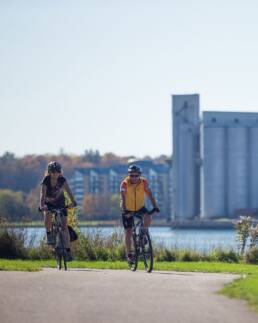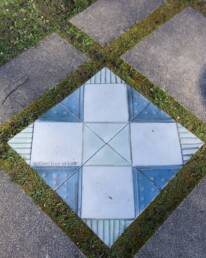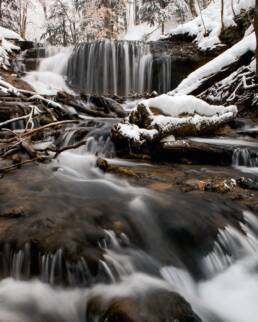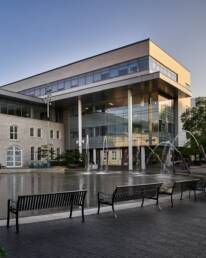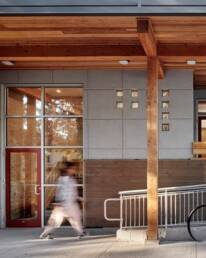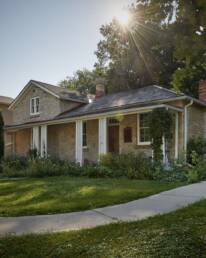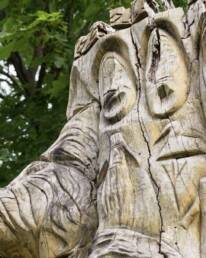Caledon
Oct 2, 2023 | Alton Mill Art Centre. Photo courtesy of Alton Mill Art Centre.
Caledon
History and heritage amidst rolling hills and conservation areas — if that’s your image of Caledon you’re not wrong. But its hamlets and villages also offer a range of cultural experiences from art galleries to on-farm breweries and markets. At just an hour outside of Toronto, Caledon makes an ideal day trip or, for those wanting to savour more of its charms, a full two-day getaway.
Day One
MORNINGALTON MILL ARTS CENTRE
NEW WINE IN OLD BOTTLES
New life created from old beauty has unique appeal, as the Alton Mill Arts Centre proves. A former 19th-century stone mill, the building was beset by floods and fires, ultimately becoming a derelict site until the late 20th century. That’s when a remarkable restoration project began, turning the historic mill into studios and galleries featuring paintings, hand-crafted clay, glass, fibre, jewellery and more. It’s a must-visit. Alton boasts another historic building-turned-gallery as well — The Paul Morin Gallery. It’s located in a former church and town hall and was restored by the Governor General’s Award-winning illustrator and artist himself. Next, from a feast for the eyes to a feast for the taste buds, consider stopping at the cozy Gather Café, the iconic Ray’s 3rd Generation Bistro-Bakery, or Headwaters Restaurant with its view of the Mill Pond and Shaw’s Creek Falls.
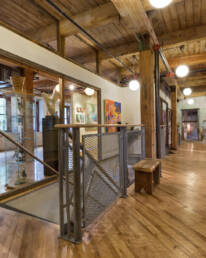
AFTERNOONCALEDON VILLAGE, BELFOUNTAIN, INGLEWOOD
A TRIO OF TOWNS
Little villages dot the Caledon region, including Caledon Village, which boasts a captivating history of its own. Take the self-guided Caledon Village Heritage Walking Tour to get a sense of the village in its bustling early days. That’s when the Toronto Grey and Bruce Railway ran through town, creating a prosperous community that was home to three blacksmiths, a doctor, a tailor, two shoemakers and three hotels. Visit the annual Caledon Fair to learn about the region agricultural heritage and customs. Today, the arts side of the village is flourishing thanks to the Caledon Townhall Players, who put on several plays each year.
Belfountain was developed because of nearby sandstone quarries — but that fact doesn’t capture the beauty of this locale. In 1850 it took its name from the French “Belle Fontaine,” or “beautiful fountain,” the fount in question the clear waters of the Credit River. The Belfountain Conservation Area (reservations recommended), perched on the Niagara Escarpment, defines “scenic,” with its suspension bridge spanning a stunning waterfall. Belfountain’s natural environment contributes to the culture in numerous ways, including via the annual Salamander Festival that draws attention to the endangered Jefferson salamander.
Snack options include two sweet cafés: The Belfountain Café and the Higher Ground Coffee Company. If you’re craving something local to take home, swing by HoneyComb Cottage Bee Company’s farm gate honey house for raw local honey, beeswax and candles. Speaking of local, check out the proudly “hyper-local” and organic GoodLot Farmstead Brewing Co., committed to sustainability — and beer. They have two outdoor beer gardens (May to October), live music and a four-season tasting room.
As to the third in the trio of towns, drop by Inglewood for the Inglewood Antique Market and browse newly made regional goods at Lost Bear Market. While there, grab a coffee at Lost Bear’s sister enterprise, Coywolf Coffee.
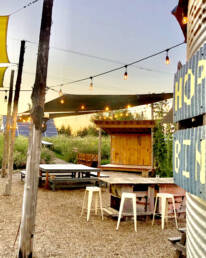
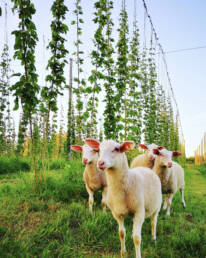
LATE AFTERNOON & EVENINGCHELTENHAM, TERRA COTTA
BRICKWORKS TO BADLANDS
Circa 1914 clay deposits around Cheltenham gave rise to the Cheltenham Brickworks, one of the first industries in the Caledon area. Today the abandoned works have a bit of a ghost town air, making for eerie viewing. Nearby Cheltenham Badlands are distinctive in an entirely different way — the ridges and gullies of red rock formed some 450 million years ago. Today they’re designated as a provincial Area of Natural and Scientific Interest, viewable three seasons and into the evening (reservations are required). The unique terrain lends its name to nearby Badlands Brewing Co., a farm brewery in a retrofitted calf bar that hosts live music in season.
For a peek into the local brickworks and carriage works history, head to Terra Cotta for a self-guided walking tour — in Caledon you’re never short of places to walk! Or ski or snowshoe, for that matter. (The Terra Cotta Conservation Area is just one of a number of conservation areas open year-round — others include the Upper Credit Conservation Area, Albion Hills
Conservation Park, Forks of the Credit Provincial Park, Bolton Resource Management Tract and the Caledon Trailway.) Consider capping off your day by dining in a beautiful setting alongside the Credit River at the Terra Cotta Inn.
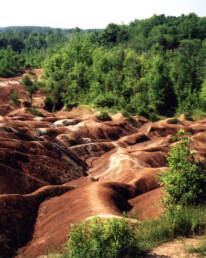
Day Two
MORNINGCALEDON EAST
FROM RAILWAY TO TRAILWAY
Walk it, bike it, ski it or even ride your pony on it — the Caledon Trailway is 35 kilometres tracing the former Hamilton & Northwestern rail line, now open to non-motorized traffic of all descriptions. Sometimes that includes wildlife, so keep your eyes open for herons, snapping turtles, deer, wild turkeys and more. It’s also where you’ll find Caledon’s Walk of Fame, honouring local luminaries from filmmaker Norman Jewison to the founders of the McMichael Canadian Art Collection. If your trailway exercise makes you peckish, head to family-run Rock Garden Farms (Easter to Thanksgiving) for fresh local produce and baked goods. Or check out
local favourite spots the Villa Caledon Inn, Tom’s Family Restaurant, Four Corners Bakery, or Indian Spice Culture Sweets & Restaurant.
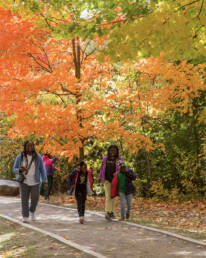
AFTERNOONPALGRAVE
MAGNIFICENT HORSES
The community of Palgrave, located on the Oak Ridges Moraine, may be best known for one magnificent animal — the horse. The Caledon Equestrian Park was built for the 2015 Pan American Games and has become so associated with its location that horse people sometimes refer to the world-class showgrounds simply as “Palgrave.” Visitors, whether horsey or not, can thrill to the ballet of dressage and drama of show jumping while enjoying the beautiful grounds themselves. Caledon is serious horse country — you may even spot an equine or two while exploring the Palgrave Forest and Wildlife Area, where trails wind through coniferous plantations, sandy meadows, and sugar maple forests in a 306-hectare greenspace. To rest and reenergize, drop into the Palgrave-based Caledon Hills Brewing Company — a church-turned-brewpub.

LATE AFTERNOON & EVENINGBOLTON
GRIST FOR THE HISTORY MILL
George and James Bolton built the first water-powered grist mill on the Humber River in 1822, and the town named in their honour expanded to become Caledon’s biggest centre and first Heritage Conservation District. Take a deep dive into the 19th century through not one but three self-guided heritage walking tours. As you make your way through Bolton’s core, you’ll be treated to more recent history in the form of vibrant murals, including the eye-catching “In Bloom,” celebrating Ontario’s diverse flora. Locally made public art is also available to view at the Humber River Centre, a community space in a renovated Fire Hall that opened in November 2023. As to community, Bolton’s citizens include a sizeable Italian population, making it an excellent place to seek out Italian cuisine. Among the many possibilities, Fratelli Molinaro, Belsito Trattoria, Casamici and Allegro Fine Foods. Though it must be said, other cuisines may tempt as well — delish possibilities for Indian food include Mohan Dhabba and Caledon’s Curry and Cocktail.
YOUR TRIP AT A GLANCE
SEE & DO
Alton Mill Arts Centre
Albion Hills Conservation Park
Artful Caledon
Belfountain Conservation Area
Bolton Resource Management Tract
Caledon Fair
Caledon Townhall Players
Caledon Trailway
Caledon Village
Caledon Village Heritage Walking Tour
Cheltenham Badlands
Forks of the Credit Provincial Park
Paul Morin Gallery
Terra Cotta Conservation Area
Upper Credit Conservation Area
Higher Ground Coffee Company
HoneyComb Cottage Bee Company
NEED A MAP?
This guide represents a weekend-long experience, highlighting one of the many wonderful destinations in the area. To suggest a destination for a future guide, please contact us.
Ontario Culture Days thanks its tourism partner Town of Caledon for their support and assistance with this article. All editorial decisions were made at the sole discretion of Ontario Culture Days staff. This guide was written by Li Robbins.
Owen Sound, Path to Freedom
November 10, 2022 | Photo by Melissa Crannie
Owen Sound, Path to Freedom
Owen Sound has been called “The Scenic City” with good reason. At the mouths of the Pottawatomi and Sydenham Rivers, it’s beautifully situated. It’s also home to fascinating history as the northernmost “station” on the Underground Railroad — the path to escaping slavery once the British Empire abolished it in 1834. Make sure to take time to explore the city’s fine museums, eat equally fine food, and check out the Sound’s great music scene. It’s a small city, but it has a big personality.
MORNINGWEST SIDE TOUR
FROM SALVATION CORNERS TO DAMNATION CORNERS
Owen Sound is eminently walkable. Start with a coffee on the East Side, now known as the River District, (Frogs Pond and Birgit’s Bakery Café among other spots), strolling through famously named intersections: Salvation Corners (many churches) and Damnation Corners (infamous taverns of yesteryear). Head west to delve into history and architecture. The West Side Tour has over a dozen stops including the Kennedy Foundry, a machine shop that built WWll ship propellors and was one of a number of Owen Sound businesses to employ Black workers. Molock House was the home of Francis Ebenezer Molock, who escaped from slavery with help from famous Underground Railroad “conductor,” Harriet Tubman. An early congregation of what’s now known as the British Methodist Episcopal Church held Owen Sound’s first Emancipation Picnic, a tradition that continues to this day. On the architecture tip: look out for Wilkinson House, restored to its Arts and Craft beauty, as well as notable examples of homes in the Queen Anne Revival style.
AFTERNOONA MUNIFICENCE OF MUSEUMS
ROOTS AND WINGS
There’s no denying that Owen Sound, built along the Niagara Escarpment within the Bruce Peninsula, has unique natural beauty, including four gorgeous waterfalls in the area. But there are also wonders created by human hands, evidenced in some excellent museums and galleries focused on telling regional stories. There’s the story of Canada’s most famous flying ace, told at the Billy Bishop Home & Museum. There’s the story of Grey County’s diverse roots: Grey Roots Museum & Archives commemorates the struggles and victories of the area’s Black community. Then there’s the story of Tom Thomson. The Tom Thomson Art Gallery honours the iconic artist (who grew up north of Owen Sound), as well as hosting a collection of contemporary artists who engage in landscape, as Thomson himself so famously did. And you’ll find local art throughout the city – look out for more than 20 public artworks produced by the Gallery or independent artists and collaborators.
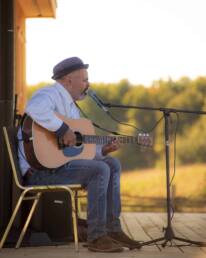
AFTERNOONHARRISON PARK
WALK THE FREEDOM TRAIL
Harrison Park’s Freedom Trail is both figuratively and literally a moving way to explore some of the story of Black settlers in Grey County. It’s a ten-kilometre self-guided trail connected to former slaves who lived and worked in the area. Visit the Black History Cairn, designed by Bonita Johnson de Matteis, a local artist who herself is a descendant of escaped slaves. The cairn traces some of the routes people were forced to take into slavery, and pursued to take out of it. Details include windows modelled on the Little Zion Church (the first Black church in Owen Sound). In August, visitors won’t want to miss the annual Emancipation festival and picnic, held every summer since 1862 to mark the anniversary of the Slavery Abolition Act of 1834. That act abolished slavery in most British colonies, freeing enslaved Africans in a number of countries, including Canada. It’s a special event — among other things it’s thought to be the longest-running Emancipation festival in North America. Harrison Park itself has been called the “jewel in the crown” of Owen Sound with 40 hectares of streams, forest, gardens and playgrounds. Visitors may wish to stroll alongside or paddle the river, perhaps stopping by Harrison Park Inn restaurant, a favourite local landmark. Nearby, visit the Potter’s Field Monument and Interpretive Plaque in Greenwood Cemetery. The community came together to create the monument as a tribute to the memory of those interred in the Field, among them members of Owen Sound’s black community who sought freedom on the Underground Railroad. These individuals often lacked the resources or family support for appropriate burial arrangements.
EVENINGMUSIC
SOUNDS IN THE SOUND
Owen Sound is known for its lively music scene, from classical (as the home of the Georgian Bay Symphony Orchestra), to folk, blues, jazz and rock. Open mic nights and songwriters’ circles are a regular feature around town, so check out spots like Heartwood Hall, Harmony Centre, The Pub and Jazzmyn’s — the last two also popular spots to dine.
Of course, if you want to consider a full range of Owen Sound dining options have a look at the city’s “Savour Owen Sound” venues. They’re worth a visit at any time of year, though the annual, award-winning month-long Savour event may up the culinary stakes. Or visit Naagan, an Indigenous dining experience by chef Zach Keeshig, operating out of the Owen Sound Farmers’ Market. Either way, Owen Sound aims to satisfy your inner foodie with hyper-local deliciousness.
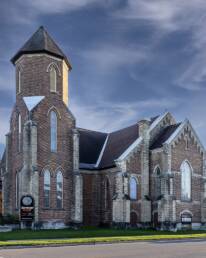
DETOUR
FALL FOR OWEN SOUNDS’ WATERFALLS
When it comes to waterfalls Ontario is rightfully renowned for majestic Niagara, but Owen Sound also claims waterfall glory, thanks to the rocky Niagara Escarpment. Inglis Falls is perhaps most spectacular of the four falls in the area, particularly in winter when intricate ice formations charm snowshoers and cross-country skiers. Pretty little Weavers Creek Falls is accessible from the south end of Harrison Park — adventurers might even hike or snowshoe from there to Inglis Falls, just two and a half kilometres on the Bruce Trail. Jones Falls, west of town on the Pottawatomi, may lure you in springtime for the exquisite Trilliums and Columbines, plus an impressive spring runoff. Last and certainly not least, the horseshoe-shaped Indian Falls: a one-kilometre walk up the escarpment (stairs ease your way) through hardwood forest, giving it definite autumnal appeal.
YOUR TRIP AT A GLANCE
YOUR TRIP AT A GLANCE
This guide represents a weekend-long experience, highlighting one of the many wonderful destinations in the area. To suggest a destination for a future guide, please contact us.
All editorial decisions were made at the sole discretion of Ontario Culture Days staff. This guide was written by Li Robbins.
Guelph
August 5, 2022 | Photo Credit Brandon Marsh Photography
Guelph
Guelph is famed for world-class arts festivals, its historic downtown and beautiful waterways, the Speed and Eramosa Rivers, as well as the birthplace of “In Flanders Fields” poet, John McCrae. Oh, and then there’s the beer. Seriously, the abundance of excellent craft beer has led some to declare Guelph as truly “brewtiful.”
Day One
MORNINGCIVIC MUSEUM
THE STORY OF A CITY
You can’t miss this museum — it’s located next to the stunning Basilica of Our Lady, an impressive example of High Victorian Gothic Revival style reminiscent of a medieval French cathedral. The museum itself shares Guelph stories from the era long before colonization — Guelph is built on the homelands of Anishinaabek peoples – to the city’s founding to present-day life in this diverse and vibrant community. The museum is a place to learn, and a place to play. Many a child has revelled in the The Families Gallery with its cool, interactive exhibits.
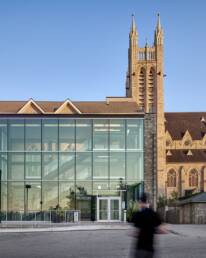
AFTERNOONMARKET SQUARE
THERE’S MAGIC IN THE SQUARE
Some city squares have a kind of magic to them, and Market Square is definitely one. Pretty in winter when ice skaters twirl, and sweet in summer when the rink turns into giant splash pad. At any time of year the historic limestone buildings make it a charming place to watch the world go by. The charm is partly by design — it’s a modern take on the original 1800s market district. Also, Market Square is home to Guelph’s impressive City Hall, live performances, and events including the annual fall Jazz Festival. Plus, there are plenty of tasty treats nearby, with downtown restaurants just steps away. (A few possible spots to choose from: Planet Bean Coffee, Eric the Baker, La Cucina, Eat Thai, and Rise and Shine Island Flavour.) Guelph, it should be noted, is serious about food! Not surprising given its agricultural roots and embrace of culinary diversity.
AFTERNOONTHE JUNCTION & SUNNY ACRES; THE WARD & ST. GEORGES
THE JUNCTION AND THE WARD
Two of Guelph’s most intriguing neighbourhoods are adjacent to downtown. To the east, it’s St. Patrick’s Ward and St. Georges (sometimes just called “The Ward”) with architecture ranging from war-time bungalows to stately Victorian homes. The Ward is also where you’ll find Guelph Little Theatre, which lives up to its slogan: a little theatre with big productions. GLT has a big history too, bringing outstanding amateur performances to theatre-goers since 1935. Next, head west to the Junction & Sunny Acres neighbourhood, the “junction” part of the name a nod to the former Guelph Junction Railway. You can see a living celebration of local railway history via “Blossom Junction,” a train made entirely of flowers. Also, don’t miss Heritage Hall nearby, current home of the Guelph Black Heritage Society. It holds a powerful history, having been built by former fugitive slaves who arrived via the Underground Railroad. Check the Heritage Society’s calendar for events that speak to that history through music, spoken word and more.
EVENINGRIVER RUN CENTRE
ARTS ON THE RIVER
The River Run is Guelph’s premiere performing arts centre, beautifully situated on the banks of the Speed River. The entrance alone is worth the visit with its copper wall a creation of Guelph artist Peter Johnston, and one that traces the history of those who’ve lived along the river from its earliest days. The centre itself opened in 1997, but a former inhabitant of the site, the Speed Skating Rink, provided entertainment of its own right. Once upon a time, orchestras played graceful waltzes as skaters circled the rink. Today, The River Run Centre is the place to go for a full range of performing arts including concerts, musicals, plays, dance and shows aimed at the whole family.
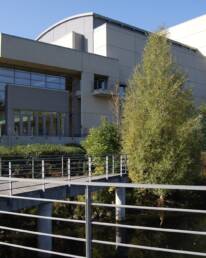
Day Two
MORNINGTHE ARBORETUM
A WORLD OF TREES
Open from dawn ‘til dusk, the outdoor Arboretum is a living classroom for University of Guelph students and faculty but it’s also a relaxing place for all to stroll. The extensive gardens, forests and trails include thematic collections like Native Trees of Ontario, centred around the conservation of the province’s native woody plants. And “World of Trees” is truly that — more than 400 species of trees and shrubs that help connect the dots between the similarities and differences of the northern hemisphere’s woody plants. There are plenty of walking trail possibilities, including The Trillium, a loop through ten plant collections, and the Mtigwaaki, designed in collaboration with Anishinaabe elders, knowledge holders and environmental scientists to share an understanding of the forest from an Anishinaabek perspective.
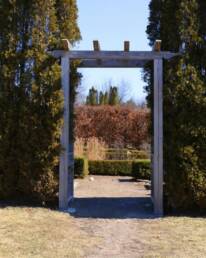
AFTERNOONART GALLERY OF GUELPH
ART IN THE GALLERY, ART IN THE GARDEN
The AGG is one of Canada’s leading galleries and sculpture parks, so naturally you’ll want to visit both. The only question is: where to start, inside or out? The Donald Forster Sculpture Park is the largest sculpture park at a public gallery in Canada, with diverse work by Canadian as well as international sculptors. Inside, there’s a strong focus on Indigenous and contemporary Canadian art, including a unique collection of Inuit drawings. Don’t miss the contemporary Canadian silver collection, the only one of its kind at a public gallery in Canada, and a top-notch showcase of the beautiful art of silversmithing.

AFTERNOONMCCRAE HOUSE
“THE LARKS, STILL BRAVELY SINGING…”
In Flanders Fields, the poppies blow…There is no more famous Canadian poem from the First World War — or possibly ever! Poet, doctor, and soldier John McCrae wrote it after a young friend died in the wake of the 1915 battle at Ypres, Belgium, not knowing the incredible impact his poem would have. Red poppies came to symbolize the soldiers who died during that war — including McCrae himself. McCrae House is the stone cottage where this extraordinary man was born in 1872, and it offers visitors a chance to learn more about the man behind the poem: from family life to his many medical and military accomplishments.
AFTERNOONROYAL CITY PARK
REFLECTION BY THE RIVER
A five-minute walk from McCrae House brings you to Royal City Park, an ideal place to contemplate all that’s come before. The Sacred Fire Space located here was created by local Indigenous peoples, and is used for spiritual gatherings of prayer, gratitude, and personal healing. Walk the park’s nearly five-kilometre recreational trail to discover another way of experiencing the tranquility of the riverside.
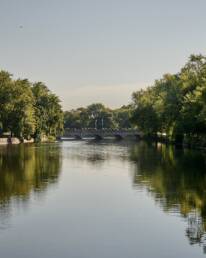
EVENINGGUELPH’S CRAFT BREWERIES
BREWTIFUL, SPIRITED GUELPH
Some around Guelph say that “beer built this town,” given the importance of early breweries to the city’s commerce. Perhaps most famous is Sleeman Breweries, which dates back to the late 19th century. Today, Guelph is famed for its craft beer, and you’ll find new favourites across the city including Brothers Brewing Company, Royal City Brewing Company, Fixed Gear, and Canada’s oldest independently owned microbrewery Wellington Brewery – all of which warmly welcome visitors. And if beer isn’t your thing, not to worry, Guelph is also home to two distilleries – Spring Mill Distillery and Dixon’s Distilled Spirits. Cheers!

YOUR TRIP AT A GLANCE
SEE
The Basilica of Our Lady Immaculate
The Civic Museum
The Royal City Families Gallery
Guelph Little Theatre
Heritage Hall
The River Run
John Galt Park/Locomotive 6167
The Arboretum
The Trillium Trail
Mtigwaaki Trail
University of Guelph
Donkey Sanctuary of Canada
Honey Bee Research Centre
Art Gallery of Guelph
Donald Forster Sculpture Park
McCrae House
Royal City Park
Guelph Jazz Festival
HISTORY AND CULTURE TO SEE
Scugog Shores Museum
Great Blue Heron Casino
Annual Mississauga First Nation Pow Wow
Ojibway Heritage Interpretive Lands
Scugog Shores Museum Village
The Dragon Boat Festival
Port Perry Fair
Port Perry Lakefront Farmers’ Market
Bird’s Eye Park
Ocala Winery & Orchard
The Thomas Foster Memorial
The Old Stone Church
YOUR TRIP AT A GLANCE
This guide represents a weekend-long experience, highlighting one of the many wonderful destinations in the area. To suggest a destination for a future guide, please contact us.
All editorial decisions were made at the sole discretion of Ontario Culture Days staff. This guide was written by Li Robbins.
Durham Region North
May 18, 2022 | Photo: Image reproduced with the permission of Ocala Winery & Orchards
Durham Region North
From lake to lake — Scugog to Simcoe — Durham Region North is a rural Ontario destination known for rolling farmlands, charming towns, and the Oak Ridges Moraine, one of the most important formations in Ontario’s greenbelt. All that, plus a vibrant arts and cultural scene.
Day One
MORNINGSCUGOG SHORES MUSEUM
SCUGOG HERITAGE AND HISTORY
Some believe the word “Scugog” comes from the Mississauga “sigaog,” meaning “waves leap over a canoe.” Others, that it’s an Ojibwe word meaning swampy land. Either way, Lake Scugog is at the heart of Scugog Township, and the result of the Scugog River being dammed in 1834. Scugog Shores Museum, located on Scugog Island overlooking Port Perry, is a great way to get a sense of the history. The island is home to the Mississaugas of Scugog Island First Nation, owners of local attraction Great Blue Heron Casino, and hosts of the annual Mississauga First Nation Pow Wow. To explore the cultural history of the Scugog watershed before Europeans arrived, visit the museum’s Ojibway Heritage Interpretive Lands. You can also get a sense of 19th century daily settler life at the Scugog Shores Museum Village.
AFTERNOONPORT PERRY
GALLERY HOPPING IN PORT PERRY
Hard to think of a nicer lakeside spot than Port Perry with its Victorian-era downtown that brims with boutiques, restaurants, galleries and antique shops. (Its charm makes it a frequent film and TV shoot location.) Port Perry is also a base for festive goings on, including Theatre On The Ridge, The Dragon Boat Festival and the award-winning Port Perry Fair. Make time to gallery hop though, since there’s an abundance of possibilities: Meta4 Contemporary Craft Gallery, Croftbeg Studio/Gallery, and Kent Farndale Gallery, among others. Be sure to visit Scugog Arts, a community arts hub featuring cultural events, local art – including the work of artists from Mississaugas of Scugog Island First Nation – and more.

AFTERNOONPALMER PARK
AN AFTERNOON IN THE PARK
Palmer Park is part of Port Perry’s appeal, a scenic waterfront right downtown. Perfect for a picnic, it’s also conveniently close to restaurants and cafés, including the lakeside Boathouse Grill, Piano Inn and Café, and The Pantry Shelf. Water is a theme, with a splash pad for the kids and plenty of folks fishing nearby. (In winter the lake is dotted with ice fishing huts.) Summer Saturday visitors will want to check out the Port Perry Lakefront Farmers’ Market for its local products and artisanal goods. Adjacent Bird’s Eye Park provides tranquil walks with stunning views of the lake.
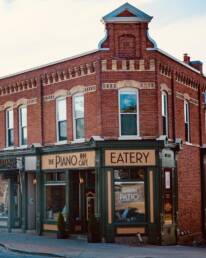
AFTERNOONOCALA WINERY & ORCHARD
VISIT THE VINES
Just a twelve minute drive south west of Port Perry you’ll find Durham Region’s only grape grower, with twenty-five varieties of fruit and six varieties of grapes. Ocala Winery & Orchard dates back to 1912, and you can still enjoy the century-old apple orchard — and maybe a wine tasting too. (If beer’s the thing, drop by local craft brewers, Old Flame Brewing Co. back in town.) Dinner in Port Perry is always a good option. A few popular spots include The Foundry Kitchen & Bar, Pickles and Olives Bistro, and Marwan’s Global Bistro.
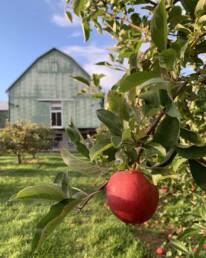
EVENINGTOWN HALL THEATRE
GO TO TOWN (HALL) FOR ENTERTAINMENT
The Town Hall Theatre building has been a Port Perry landmark in the community throughout its century-and-a-half history. And what a history it is: it’s served as municipal town hall, fire station, courthouse, roller skating rink, undergarment factory, movie theatre, and, since the 1970s, a live performance venue. Today it’s a prime spot for award-winning plays and musicals, live jazz, blues and classic rock, comedy, improv, kids shows and more – check the events calendar for more. No wonder it’s considered the centre for performing arts in Durham Region.
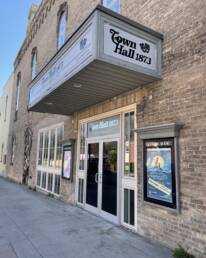
Day Two
MORNINGUXBRIDGE SELF-GUIDED ART TOUR
ART IN THE VALLEY
Uxbridge Township is officially designated “The Trail Capital Of Canada,” given its 220 kilometers of managed trails. But the town of Uxbridge itself, located in an Oak Ridges Moraine valley, is also known for its art and artists, as a self-guided downtown walking tour reveals. Uxbridge also has a strong music history, with one of its earliest industries the Uxbridge Organ Co., established in 1872. Its legacy as a music town lives in in the Music Hall, known for excellent acoustics and beauty, its balcony graced by original opera chairs behind a carved iron railing. Should you need caffeination one favourite is The Bridge Social with its pithy slogan: “Coffee. Trails. Repeat.” Uxbridge is also chockablock with restaurants of all kinds, from tacos to sushi to deli to burgers, making it an ideal lunch stop.
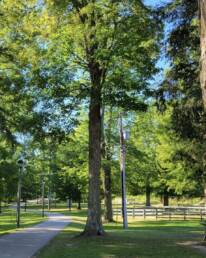
AFTERNOONTHOMAS FOSTER MEMORIAL
THE TAJ MAHAL OF ONTARIO
The Taj Mahal in India, dating back to 1632, was the vision of Mughal Emperor Shah Jahan. The Thomas Foster Memorial, dating back to 1935, was the vision of one-time Uxbridge boy Thomas Foster, who’d visited the Taj Mahal and was inspired to construct his own mausoleum. Foster, who went from working as a butcher’s boy in Toronto to becoming the city’s mayor in 1925, left behind this eye-catching monument, a startling sight on a hilly road in rural Ontario. A beautiful one too, with marble, frescoes, stone pillars and stained glass. During summer months you can hear live music, from folk to jazz.
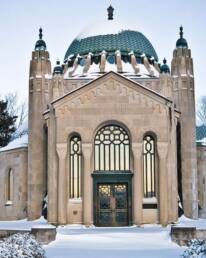
AFTERNOONLEASKDALE MANSE
ANNE OF LEASKDALE
Beloved children’s book author Lucy Maud Montgomery is best known for Anne of Green Gables, set in Prince Edward Island. But she wrote 11 of her 22 published novels in Leaskdale (just north of Uxbridge) from 1911 to1926, where she lived with her minister husband and her sons. Today her husband’s church, St. Paul’s Presbyterian, is a museum filled with L.M. Montgomery memorabilia and the manse has been restored to reflect what it was like in the famous “Anne-with-an-e” author’s time. If you want to explore the area a little further, try driving the Leaskdale Loop, a 20 kilometre cornucopia of maple syrup, farm fresh vegetables, baked goods and local honey.

AFTERNOONSUNDERLAND, CANNINGTON, BEAVERTON
THE VILLAGES OF BROCK
Durham Region’s northernmost township is Brock, bordered by Lake Simcoe on the west and home to three distinct villages. Why not visit each one as you make your way to the shores of Lake Simcoe. Sunderland, in the midst of farmland, is home to the historic Sunderland Town Hall (1871), the hundred-plus years fall fair, and the popular Maple Syrup Festival. Cannington has both the charm of Victorian era architecture and the practicality of being a great jumping off point for hikers. Finally it’s Beaverton, where the Beaver River and Lake Simcoe meet. Cottagers and day trippers alike enjoy Beaverton’s harbour by summer, and winter months bring avid ice-fishers to its shores. Have a peek at The Old Stone Church, a modest yet striking building from the mid-nineteenth century, and one of the few original stone churches in Canada.
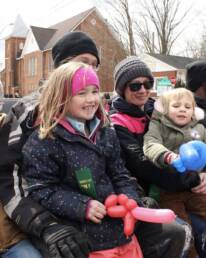
EVENINGBEAVERTON TOWN HALL PLAYERS
LET THEM ENTERTAIN YOU
Local theatre with a heartfelt motto: “Let Us Entertain You,” The Beaverton Town Hall Players put on concerts, musicals, comedies and dramas in the restored 1910 town hall-turned-performance space (check for dates and times before visiting). Boasting a friendly, intimate atmosphere, the theatre group’s mix of professional and amateur players has delighted audiences for the past three decades.
YOUR TRIP AT A GLANCE
HISTORY & CULTURE
Annual Mississauga First Nation Pow Wow
Bird’s Eye Park
The Dragon Boat Festival
Great Blue Heron Casino
Ocala Winery & Orchard
Ojibway Heritage Interpretive Lands
The Old Stone Church
Port Perry Fair
Port Perry Lakefront Farmers’ Market
Scugog Shores Museum
Scugog Shores Museum Village
The Thomas Foster Memorial
NEED A MAP?
This guide represents a weekend-long experience, highlighting one of the many wonderful destinations in the area. To suggest a destination for a future guide, please contact us.
Ontario Culture Days thanks its tourism partners Durham Region for their support and assistance with this article. All editorial decisions were made at the sole discretion of Ontario Culture Days staff. This guide was written by Li Robbins.
Durham Region South
April 29, 2022 | Photo: Pickering Marina. Credit: Captured by Sage
Durham Region South
Durham Region South is conveniently located a stone’s throw from Toronto and offers day-tripping possibilities galore. The region hugs Lake Ontario from Bowmanville to Pickering, making it easy to skip from location to location — and savour lakeside vistas. The lake and the land have held significance for centuries, as the Mississaugas, a branch of the Ojibwa Nation, moved into region circa 1700.
Day One
MORNINGVISUAL ARTS CENTRE OF CLARINGTON
SMALL TOWN CHARM IN BOWMANVILLE
Known for both its art exhibitions and unique location, the Visual Arts Centre of Clarington is in a 19th century barley mill on the banks of Soper Creek. It features both local and national contemporary visual art (and a glorious loft space with original wooden beams soaring overhead). It’s also an education centre, hosting artist talks aimed at making art an interactive exchange of ideas. Regular visitors, get your hands wet! Painting and pottery classes are on offer.
Bowmanville is a charmer with its walkable historic downtown, classic Canadian main street, and grand Victorian mansions. Caffeinate at Roam Coffee or The Toasted Walnut (the latter also serves up homemade meals) or shop at Market By Dream Day (“your one-stop shop for everything local.”) Once the sun is over the yard arm consider a visit to local craft brewery, Chronicle Brewing.

MORNINGTYRONE MILLS
POWERED BY WATER (AND APPLE CIDER)
Alternatively, spend the first half of the day out at Tyrone Mills. For over 170 years Tyrone Mills (a thirteen minute drive north of Bowmanville) has served as a grist, flour and lumber mill. Today, it still uses water power for lumber manufacturing and flour production. Take a tour of the mill or sample local wares and baked goods (apple cider donuts, anyone?). Speaking of apples, en route to the mill drop by Archibald’s Estate Winery, specializing in apple wine recipes. Discover the many temptations of apple-based wines, from sweet to dry, in a complimentary tasting.
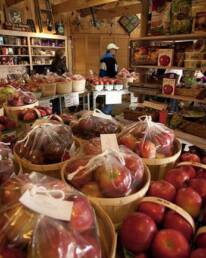
AFTERNOONURBN | MRKT OSHAWA
NOSH IN OSHAWA
Opened in 2021 in a downtown Oshawa landmark, the former RBC building, URBN MRKT has quickly become a favourite spot, with tasty snacks ranging from Korean barbeque to classic Quebec poutine. It’s the place to shop for farm-fresh local produce and artisanal products — more an experience than a stroll through your average grocery store! If a sit-down restaurant’s your thing, downtown Oshawa has plenty on offer, including Street MoMo’s Indian-Asian cuisine or The White Apron’s “comfort classics.”
AFTERNOONOSHAWA MUSEUMS
BOOKEND YOUR DAY WITH ART…
Visit Oshawa’s Robert McLaughlin Gallery, known for the most extensive collection in Canada of the Painters Eleven — Ontario abstract painters who helped popularize the art form. While the gallery’s main focus has historically leaned European-ward, you’ll also find striking work by Indigenous artists. As for the gallery’s name, it’s a tip of the hat to the founder of what became General Motors Canada. (The auto baron’s former residence, The Parkwood Estate, also makes for an interesting visit.) The RMG itself was expanded in 1987 by famed architect Arthur Erickson, who created its dramatic, light-filled lobby.
…OR BOOKEND YOUR DAY WITH HISTORY
Oshawa is sometimes viewed as the eastern anchor of the Greater Toronto Area, and it’s rich with history. For example, the automotive legacy — it’s historically known as Canada’s Motor City, as a visit to the Canadian Automotive Museum demonstrates. You’ll find another significant vehicle display at the Ontario Regiment RCAC Museum, with the largest collection of military vehicles in North America. To learn about the history of Oshawa residents, including the area’s Indigenous past and the history of its Black population (the latter dating back to at least 1850), head for the Oshawa Museum, nestled on the shores of Lake Ontario.

Day Two
MORNINGLYNDE HOUSE MUSEUM
THE OLDEST HOUSE IN DURHAM
Whitby is home to the Lynde House, named for Jabez Lynde, a United Empire Loyalist who served in the war of 1812. During that time his home became an inn, a tavern, and a supply depot where the British and First Nations militia could load up heading to battle. Since then the house has moved twice (with thousands lining the streets to watch) to its current location. In summer, savour Clarissa Lynde’s Heritage Kitchen Garden, with plantings typical of the 1800s — chamomile, calendula, yara, savoury and the like. Or drop into the little brick building next door, the Warren General Store, for gifts, home décor and sweet treats.
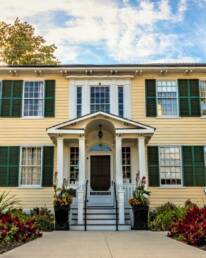
AFTERNOONSTATION GALLERY
ART IN THE GRAND TRUNK RAILWAY STATION
Arts and culture abound in the region, and the Station Gallery has been celebrating that fact since 1967 when passionate arts enthusiasts opened the first community gallery. Next, they bought the local Grand Trunk Railway Station (for a dollar — it was slated for demolition) and made it the gallery’s new home. Today the renovated station features exhibitions by emerging, mid-career and established artists, as well as classes, workshops, performances and special events, making it “a champion of all things empowering and creative.”
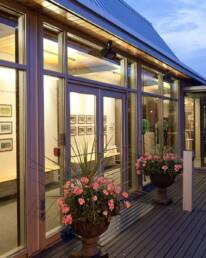
AFTERNOONAJAX
WEND YOUR WAY ALONG THE WATERFRONT TRAIL
Before exploring Ajax’s impressive 400 hectares of open space, parks, playgrounds and conservation areas, consider a lunch stop. Two possibilities: The Portly Piper for classic pub fare, or Maimana Naan & Kabab for its cultural crossroads of Afghani, Indian, Greek and Iranian-inspired cuisine. After that, yes to exercise! No better place than the Waterfront Trail, winding through Ajax’s lovely parks. Along the way, linger at Veteran’s Point Gardens. It’s a contemplative spot where you can absorb the history of Ajax and World War ll, and its intriguing design conjures up the shape of a ship.
AFTERNOONPICKERING NAUTICAL VILLAGE
RELAXING IN THE VILLAGE
Frenchman’s Bay is home to the unique waterfront community of Pickering Nautical Village. Between the beach, the boardwalk, and the boat launch there’s something for everyone. (Including a splash pad, swings and slides for the kids.) Open Studio Art Café has live art (life drawing) and live music (open mics and concerts). Dining choices range from North American bistro fare at Port, with waterfront views, the Mexican-inspired Chúuk, and Zeera By The Bay for traditional Indian food. (Note too that Pickering is home to mouth-watering Caribbean deliciousness, found at Beryl’s Pepper Pot, Roti N’Ting and Yardies Carribean Cuisine, among others.) For afters consider GrandDad’s Old Fashioned Ice Cream Parlour, home to every conceivable flavour of Ontario favourites: Kawartha Dairy, Chapman’s, and Central Smith.
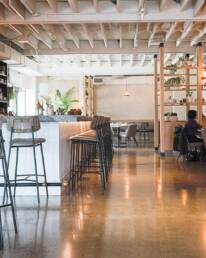
EVENINGST. FRANCIS CENTRE; HERONGATE BARN THEATRE
BE ENTERTAINED IN A FORMER CHURCH…OR BARN
Have a look at what’s on at St. Francis Centre for Community, Arts & Culture or the Herongate Barn Theatre. St. Francis, built in 1871, is an excellent example of High Victorian Gothic church architecture. It’s also an excellent example of a state-of-the-art performance space for music, theatre and comedy. A fifteen-minute drive away you’ll find another unique entertainment setting: Herongate Barn Theatre, housed in a century-old dairy farm. Dine in a former bull pen or hay manger then head up to the renovated loft for laughs or gasps — the Herongate specializes in staged comedies and mysteries. Check the event calendars to keep up with the wide variety of events at these venues.
YOUR TRIP AT A GLANCE
YOUR TRIP AT A GLANCE
This guide represents a weekend-long experience, highlighting one of the many wonderful destinations in the area. To suggest a destination for a future guide, please contact us.
Ontario Culture Days thanks its tourism partners Durham Region for their support and assistance with this article. All editorial decisions were made at the sole discretion of Ontario Culture Days staff. This guide was written by Li Robbins.
Peterborough
Photo courtesy of Destination Ontario.
Peterborough
Peterborough is built on the shores of the Otonabee River, first known as Nogojiwanong, which is Ojibwa for “place at the end of rapids.” The Otonabee (or Odenabe, “river that beats like a heart”) isn’t the only waterway to criss-cross the city: a canal (part of the Trent-Severn Waterway) and a creek (Jackson) also run through it. So, Peterborough’s culture is intrinsically linked to this unique and striking setting.
Day One
MORNINGTHE CANADIAN CANOE MUSEUM
A CANOE ON EVERY CORNER
You know you’re in Peterborough when you spot a canoe on practically every corner. Some are land-bound, like the art installation Jiimaan’ndewemgadnong — The Place Where the Heart of the Canoe Beats, at the corner of King and Water Streets, by Anishinaabe artist Tia Cavanagh.
But there’s no better place to understand the canoe’s significance than the Canadian Canoe Museum. It’s the world’s largest collection of paddled crafts, filled with stunning, historic canoes and kayaks. The collection spans from the First Nations of the Pacific Northwest’s huge dugouts to bark canoes of Newfoundland’s Beothuk. In 2023 the museum is poised to expand in a new location and building on the water, with more exhibits to reflect its collaborative relationships between Indigenous and non-Indigenous peoples.
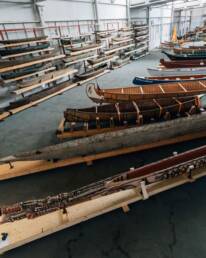
AFTERNOONHUNTER STREET CAFÉ DISTRICT
THE CAFÉ LIFE, PETERBOROUGH STYLE
Peterborough is a smallish city, with a population of 84,000 and change. But it boasts a vibrant café district along Hunter Street West. A couple of attractive blocks of bars, cafés and boutiques, it includes The Only Café, perched on the edge of Jackson Creek. The Only is an institution known for excellent sandwiches, eclectic décor, and as a favourite hang for everyone from students to politicians. Another long-running favourite is Black Honey Bakery — a homey, cozy café with tasty brunches and vegan options. On the shopping front, head to Hunter and George Streets for hip fashions (S.O.S.), locally-branded “Ptbo Northern Originals” wear (Flavour), or handcrafted jewelry and gifts (Hi Ho Silver).
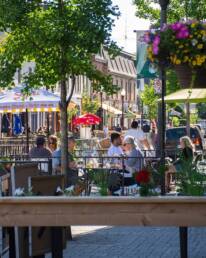
AFTERNOONHUTCHISON HOUSE
SEE HOW THE SETTLERS LIVED
Step back in time at Hutchison House, a short walk from Hunter Street. Locals built the home in 1837 to entice Peterborough’s first resident physician, Dr. John Hutchison, to stick around – they were successful. Now it sits filled with medical instruments, books and furnishings of the time. The museum also has memorabilia belonging to the good doctor’s cousin, Sir Sandford Fleming, famed engineer, scientist and inventor. Fleming’s design for a forerunner of the roller blade is one of the many charming artifacts on display. In summer, take tea on the terrace; in winter, sip beside the open hearth in the Hutchison House kitchen.
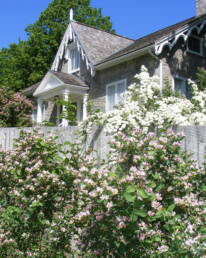
AFTERNOONLIFT LOCK
THE WORLD’S TALLEST BOAT LIFTER
A marvel of engineering, the Lift Lock its the highest hydraulic lift lock in the world and is designed to lift boats nearly twenty metres. The Lift Lock Visitor Centre explains how that’s done, as well as answers all your Trent-Severn Waterway questions (the 386-kilometre-long canal that connects Lake Ontario to Georgian Bay).
Want to get inside the Lift Lock? A Lift Lock Riverboat cruise gives you a boat’s-eye-view. Or, for the jaw-dropping experience, bring your own kayak or canoe to join in on the annual Lock ‘n’ Paddle.
In winter, skate the canal beneath the mighty lock. In summer, picnic on canal banks.
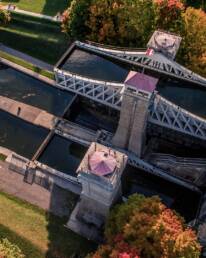
AFTERNOONART GALLERY OF PETERBOROUGH
CONTEMPORARY ART ON THE (LITTLE) LAKE
Located south of downtown on Little Lake, the AGP is a little gem of contemporary art. Its permanent collection includes work by significant regional Indigenous artists (Mary Anne Barkhouse, Michael Belmore), as well as artists from further afield (Daphne Odjig, Carl Beam, Jane Ash Poitras, and Rebecca Belmore). While you’re there, drop into the Gallery Shop for regional one-of-a-kind arts and crafts, and fun stuff for kids too. For a restful summer afternoon stop, don’t miss ice cream by the river at the cottage-like Silver Bean, just a 10-minute walk north of the gallery.
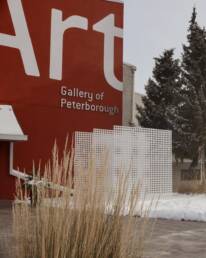
EVENINGCULINARY PETERBOROUGH
WINE, DINE, AND STROLL THE OTONABEE
Excellence and diversity are markers of the city’s culinary strengths, for instance La Hacienda’s Mexican cuisine (and adjacent mercado), Hanoi House’s Vietnamese food (and oysters) and Fresh Dreams (traditional Spanish Tapas). All are located in and around Hunter Street West, not far from the beautifully landscaped Millennium Park trail. A post-dinner easy stroll along the Otonabee includes sculptures and a display tracing the city’s Indigenous and colonization history.

EVENINGLIVE MUSIC
FROM THE BLACK HORSE TO THE RED DOG — CATCH SOME TUNES
Peterborough is a music-loving town, and two venerable establishments are The Black Horse (jazz and blues) and the Historic Red Dog Tavern (reggae, rock, and hip hop). Yes, “historic” is part of the official name, opening as a hotel in 1883, and going on to become known as “the home of live music.” Many a legendary musician (Neil Young, Ronnie Hawkins, Jeff Healey) have played the Red Dog, a tradition continuing today with both nationally-known and rising-star local acts.
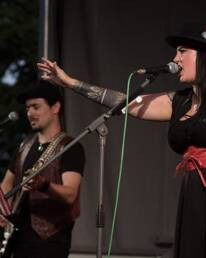
Day Two
MORNINGNOGOJIWANONG TO PETERBOROUGH (AND BACK AGAIN)
AUTHENTIC CONNECTION TO LAND, WATER AND PEOPLE
Peterborough is known by many names: The ‘Boro, The Patch, Ptbo, Electric City, and increasingly by its original Ojibwe name, Nogojiwanong. For a deeper understanding of this Indigenous culture, take the 30-minute drive north to Curve Lake First Nation. Along your way, enjoy the scenic river views for most of your drive.
There you’ll find both the Whetung Ojibwa Centre and Curve Lake Cultural Centre. The Curve Lake Cultural Centre is dedicated to keeping traditions and ceremonies alive within the community. Immerse yourself in the history and culture of the people, the Michi Saagiig Anishnaabeg, and learn about their language, geography, history, and traditions.
Two minutes down the same road, the Whetung Ojibwa Centre offers a spectacular collection of Native crafts and fine art from both Curve Lake First Nation and across Canada. In addition to the shop, there is also a museum with totem poles, headdresses, moccasins, dreamcatchers and more, all within a 10,000 sq ft building. This centre is open seven days a week, and if you are in the area at the end of summer, you are welcome to attend the annual Pow Wow.
AFTERNOONLAKEFIELD
TAKE THE SCENIC RIVER ROAD TO LAKEFIELD
Peterborough has enviable proximity to lovely lakes and charming towns. Lakefield combines both, just south of Katchewanooka Lake and right on the Otonabee. A twenty-minute drive along the winding Water Street from downtown brings you past Trent University and into picturesque Lakefield. The town’s literary history (authors Susanna Moodie, Catherine Parr Traill, and Margaret Lawrence all made their homes there) makes it the logical place for July’s annual Lakefield Literary Festival. (Resuming in 2023.) Shop Queen St., or make it your dinner stop. A few popular spots: Canoe & Paddle pub, Cassis Bistro (fine dining), and The Nutty Bean, boasting “the best verandah” in town.
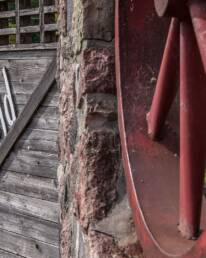
AFTERNOONPETERBOROUGH MUSEUM AND ARCHIVES
TAKE THE SCENIC RIVER ROAD TO LAKEFIELD
Finally reaching the north end of Peterborough on your drive back in, you’ll find the family-friendly Peterborough Museum and Archives tells the local story. From early Indigenous communities and the first wave of Irish immigration, and the city’s rise and fall as an industrial town and beyond, their collection speaks of it all.
For an early dinner, wander around the East City. One choice spot: Ashburnham Ale House for local beers and high-end pub grub.
AFTERNOONJACKSON PARK
FOREST IN THE CITY — A CULTURAL HERITAGE LANDSCAPE
Jackson Park is one of a handful of Ontario parks with old-growth forest, and also a recently designated cultural heritage landscape. Yet it’s only a five-minute drive from Hutchison House. Stroll around the pond, a favourite spot for waterfowl and those wishing to photograph them. Pause on the restored, 1894 pagoda bridge. Or enjoy the 4.2 kilometre Jackson Creek trail, its rushing waters your soundtrack for walking, biking, or cross country skiing — Peterborough Nordic Club maintains classic ski tracks. Omemee (songwriter Neil Young’s hometown) is also a favourite cycling destination, the 44 kilometre round trip taking you over Doube’s Trestle Bridge with spectacular views of Buttermilk Valley.
EVENINGMARKET HALL PERFORMING ARTS CENTRE
TO MARKET FOR MUSIC, OR THEATRE, OR DANCE
Located beneath Peterborough’s landmark clock tower, Market Hall is known for its theatrical and musical presentations, though it’s also a vibrant community centre, featuring political debates and more. Spacious yet still intimate, it’s come a long way since its 19th century days as a food market. Enjoy a show while testing out the local theory: the beautifully restored Market Hall hasn’t got a bad seat in the house.
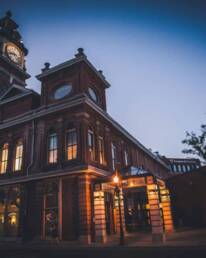
WANT TO TAKE A DETOUR?
WARSAW CAVES CONSERVATION AREA
The Warsaw Caves Conservation Area (a twenty-minute drive from Lakefield) will satisfy almost any outdoor itch you want to scratch, with scenic hiking trails, camping, and paddling, fishing or swimming on the Indian River. You can even go spelunking in the seven namesake caves, which were formed at the end of the last ice age.
YOUR TRIP AT A GLANCE
SEE
Art Gallery of Peterborough
Art Space
The Canadian Canoe Museum
Hutchison House
Jackson Creek trail
Lakefield Literary Festival
Lift Lock Visitor Centre
Market Hall Performing Arts Centre
Peterborough Museum and Archives
Showplace Performance Centre
Trent University
Warsaw Caves Conservation Area
Whetung Gallery
NEED A MAP?
This guide represents a weekend-long experience, highlighting one of the many wonderful destinations in the area. To suggest a destination for a future guide, please contact us.
All editorial decisions were made at the sole discretion of Ontario Culture Days staff. This guide was written by Li Robbins.



